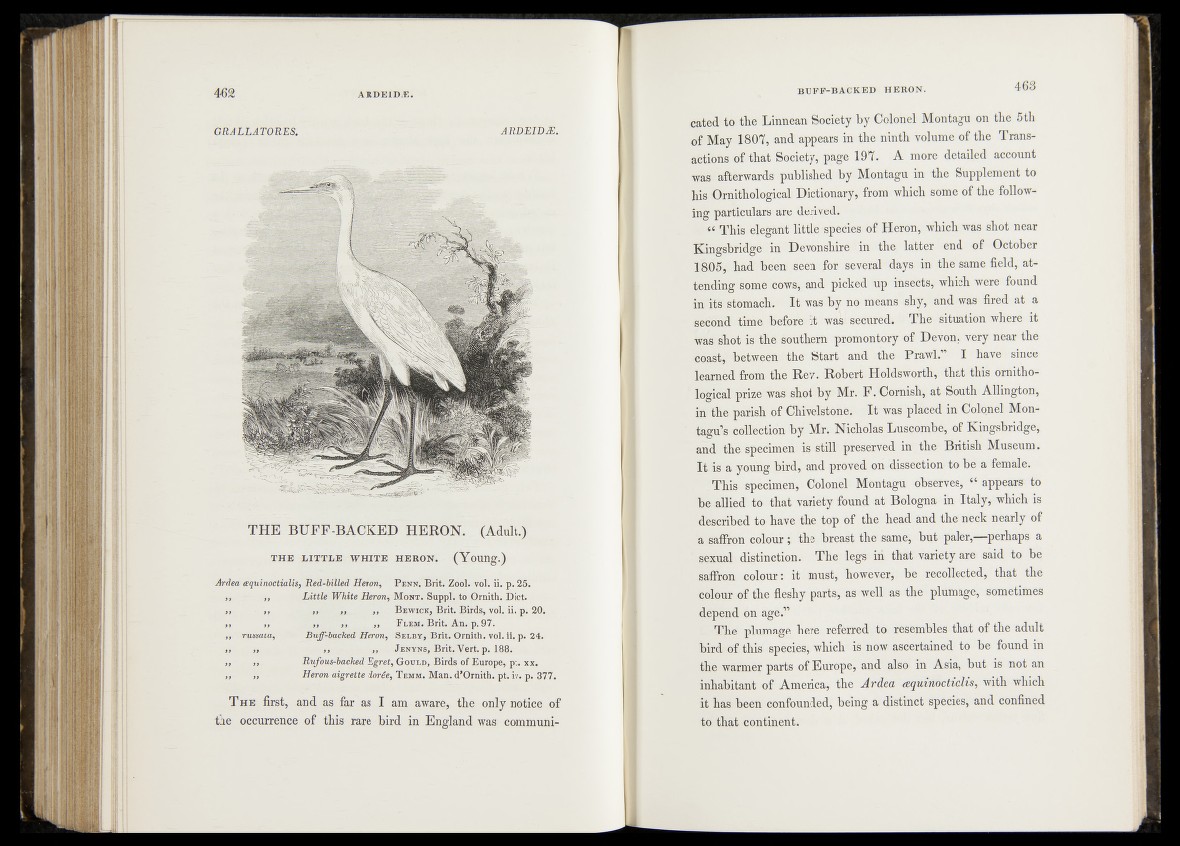
GRALLATORES. ARDEIpÆ,
T H E BUFF-BACKED H E R O N .. (Adult.)
TH E L IT T L E W H IT E HERON. .’ (Young.)
Ardea tequinoctialis, Red-billed Heron, P e n n , Brit. Zool. vol.'ii. p. 25.
| „ Little White Heron, M ont. Suppl. t o Grnith. D i e t - <
' ,r n v » B e w ic k , B r i t . Birds, v o l. i i . p . 2 0 . .
„ H H " F l e m . Brit. An. p . 9 7 .
russata, Buff-hacked Heron, S e l b y , Brit.'Ornith. vol. ii, p . 24.
, , - - ■„ , J e n y n s , Brit. Vert. p. 138.
- „ RufousJmcked Egret, Gould, Birds of Europe, pt. xx.
,, „ Heron aigrette dorde, T emm. Man. d’Ornith. pt. iv. p. 377.
T he first, and as far as I am aware, the only notice of
the occurrence of this rare bird in England was communicated
to the Linnean Society by Colonel Montagu on the 6th
of May 1807, and appears in the ninth volume of the Transactions
of that Society, page 197. A more detailed account
was afterwards published’b y Montagu in the Supplement to
his Ornithological Dictionary, from which some of the follow-
ing particulars are derived. =
“ Th|fte[egant little'species; of Heron, which was shot near
Kingsbridge in Devonshire in the latter end of October
1805, had been seen for several days in the same field, attending'some
cows, and piek’edmp insects* which were found
in 'it§ stomach. I t was by no means shy, and was fired at a
seednd time- before it wafe secured. - The situation where it
was shot is the southern promontory of Devon, very near the
coast,- between the Start and the Prawf.” I have since
learned from the Rev. Robert Iloldsworth, that this ornithological
prize was shot by Mr. F . Cornish, at South Allingtop,
in the parish of Chivelstone.- I t was placed in Colonel Montagues:
collection by Mr. Nicholas Luscombe, of Kingsbridge,
and the specimen is still" preserved in the British Museum.
I t is a young bird, and proved on dissection- to be a female.
This specimen, Colonel Montagu observes, “ appears to
be allied to . that variety found at Bologna in Italy, which is
described to have the top of the head and the neck nearly of
a saffron colour; the breast the same, but paler, perhaps a
" sexual distinction. The legs in that variety are said to be
saffron colour: it must, however, be recollected, that the
colour of the fleshy parts, as well as the plumage, sometimes
depend on age.”
,> The plumage here referred to resembles that of the adult
bird of this species, which is now ascertained to be found in
the warmer parts of Europe, and also in Asia, but is not an
inhabitant of America, the Ardea tequinoctialis, with which
it has been confounded, being a distinct species, and confined
to that continent.